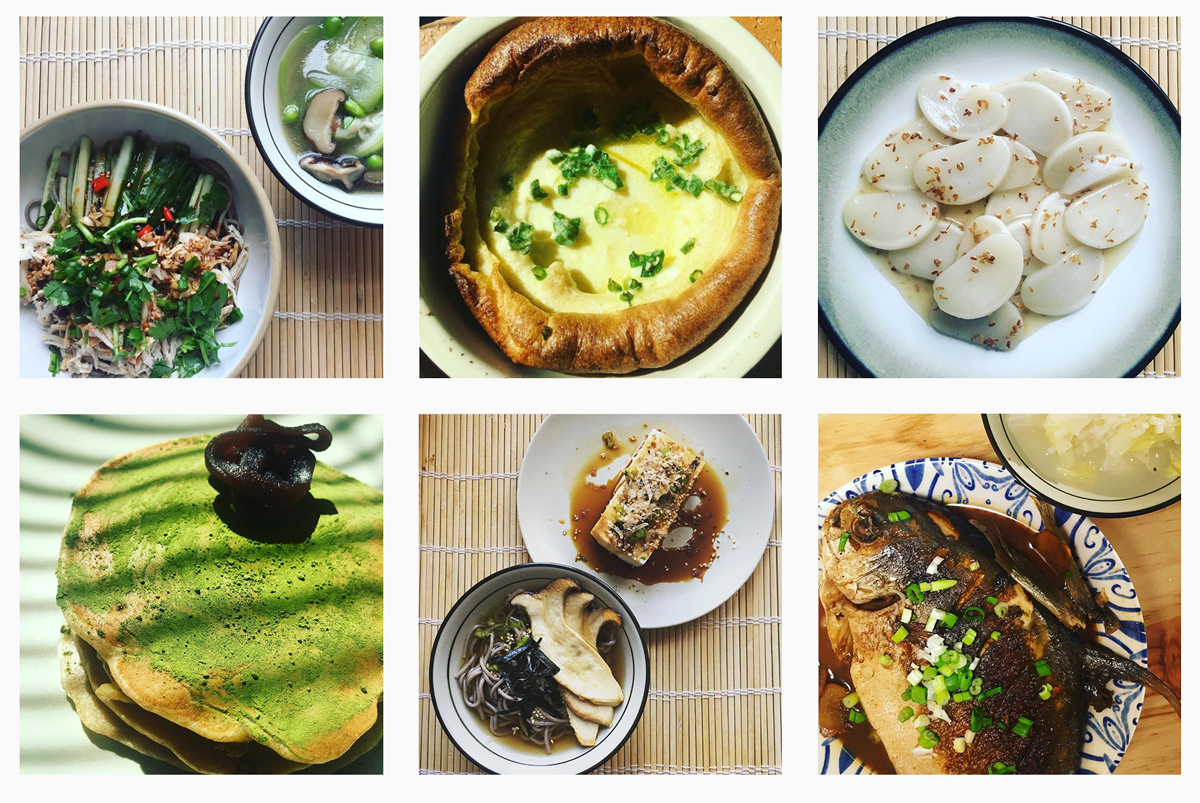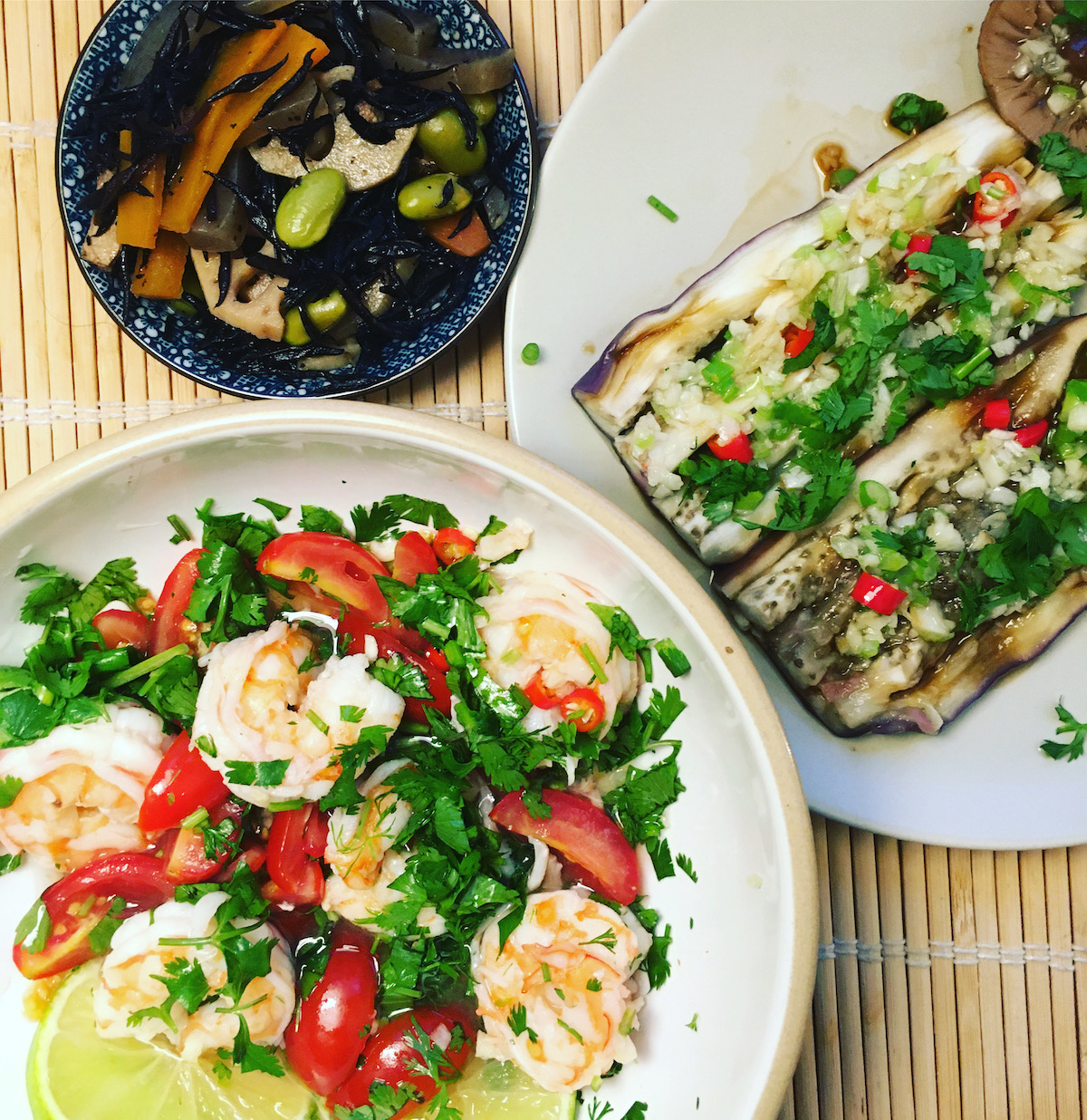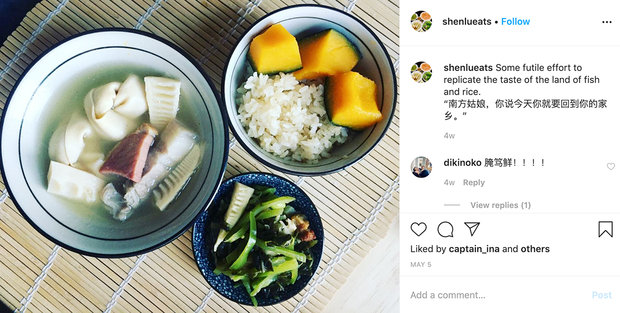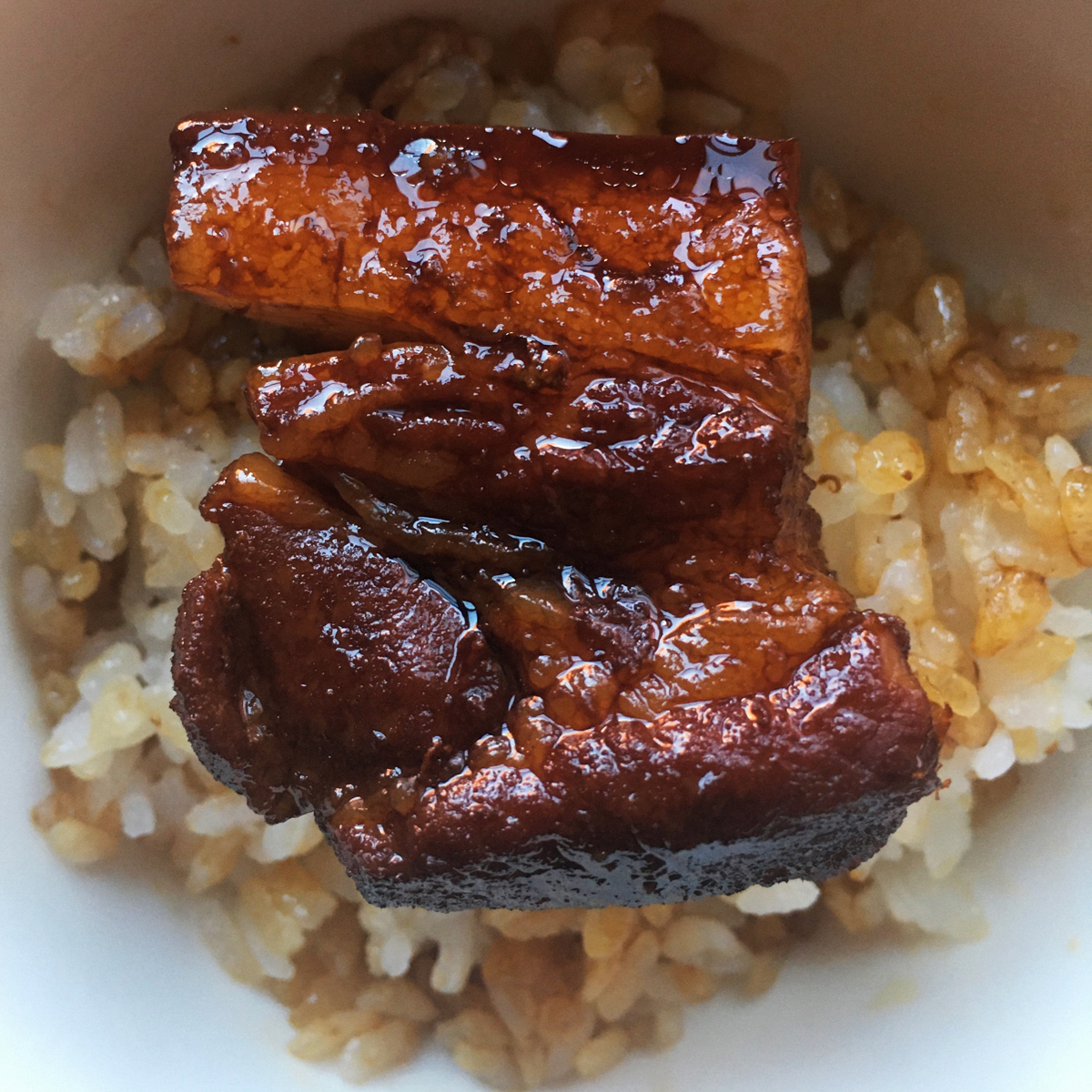I am standing in my kitchen in the middle of the day, cutting a slab of pork belly into cubes. I transfer the meat to a pot of cold water, light my stove, and stay next to it while the water comes to a boil. As I watch the pink streaks of lean meat turn pale and grow firmer in the boiling water, it occurs to me that I’ve spent far more time in my kitchen in the past two months than ever before.
I am making hongshaorou, or red-braised pork belly, a quintessential dish from the region of China where I grew up that is both homey and indulgent. Its ingredients are common, but when they come together its rich sauce turns dark and velvety with fat. In the past, I’ve limited its guilty pleasures to dinner parties with friends. But now that I’m living in an apocalypse, I figure, every day is a special occasion.
Cooking has been my daily ritual in the time of COVID-19. I skim through terrible news while thinking about my next meal. I discuss censorship on a work call while mapping out my next grocery run. I chat with friends on the phone while browsing recipes on the app Xiachufang, the home-cooking community to which Chinese citizens flocked to relieve their quarantine anxiety two months ago. I purposely let thoughts of food clutter my mind. Nothing else may feel solid, but I know at least one thing that’s certain: I can eat well.
I’ve always liked to cook. Now alone and isolated in my small Boston kitchen, I treat my culinary endeavors as a way to explore and express my complex identities and process heavy feelings. I slice doubt, wrap confusion, simmer fear, and steam despair. I sliver vegetables more finely than ever, recreate street food from scratch, and experiment constantly and with abandon. The other day, I tried a Japanese hijiki salad. Tomorrow, I plan to make cacio e pepe. The worse the news, the longer I spend in my kitchen. My food never disappoints me. The time and effort I spend on the preparation yields dependable results. It gives me a sense of control even while the entire world seems to be falling apart around me.
The dishes I make myself flavor my moods, and season my experience of the news. As my birth country and my host country cast blame on one another, I eat four-cheese pizza with a side dish of blanched cauliflower seasoned with soy sauce, vinegar, and extra chili oil. The day Trump moved to halt legal immigration into the U.S., I poured osmanthus-infused syrup over a steamed Chinese yam, tingeing the edges of my rage and despair with its bright floral sweetness. When police detained volunteers who archived censored articles about coronavirus, I threw too many bird’s eye chilies into a Thai shrimp salad and then ate it in tears.
My kitchen is my sanctuary. More than 100,000 people in America have lost their lives to the virus. Many have lost family and friends, shelter, insurance, visa status. I’m among the 40 million who have lost their jobs. I have accepted the possibility I might wake up to more loss: security, health, nonimmigrant status. But I know my appetite will stay with me. To avoid dwelling on my own problems and wallowing in a sense of helplessness in the pandemic, I station myself in my kitchen. I simmer meat stews that take hours. I cook rice in a clay pot that takes twice as long from start to finish as an electric rice cooker does. I wrap wontons that could last me three months.
I grew up in a village surrounded by mountains of bamboo in eastern China’s Zhejiang province. Every spring, I followed grown-ups to the hill next to our house to dig fresh spring bamboo shoots. We peeled off their outer husks at dinner time, and watched my grandmother cook the tender hearts for every course: steamed with pickled mustard, stewed with pork belly, tossed in a wok with broad beans or Chinese chives.
It’s been nine years since I left home for school in 2011. Each year without bamboo I have craved its crunch, its mild, earthy aroma—the ultimate taste of spring. This year, in quarantine, my desire overwhelmed me. I decided to give frozen shoots, which I’d long shunned, a try and made yanduxian—a quintessential soup made of spring bamboo, cured and fresh pork, and knots of pressed bean curd. I knew frozen bamboo probably wouldn’t bear a strong resemblance to the fresh green spears I pulled from the earth with my bare hands. Still, when I took a first bite of the watery shoots, a bubble of disappointment swelled up inside me. They lay limp in my mouth and tasted of nothing but despair. My effort to replicate the taste of spring turned out to be an act of futility. The harder I hunted for something that embodied home, the more home escaped me.
And so I’ve stopped trying. I permit myself to stray on my culinary adventure with what I can get my hands on. Surprises abound. I’ve tried miso-glazed Alaska pollock, salmon and asparagus takikomi gohan—a Japanese mixed rice dish—and grilled lamb shank with za’atar. I didn’t worry about pairing Thai shrimp salad with Hunan-style stir-fried cauliflower. Eating okonomiyaki with shepherd’s purse wonton soup felt perfectly right. During the pandemic, I’ve found a new freedom in modifying ingredients in dishes I grew up eating, or even improvising recipes I’m cooking for the first time. I’m no longer constrained by regard for authenticity or vague memories of how something tasted when I was a child. My food has taken on an ambiguous and promiscuous identity, just like me.
And a strange thing has happened. The more I’ve ventured into culturally distant dishes, the more the tastes of home have reasserted themselves, finding me where I least expect them. I make risotto without cheese, adding huotui—Chinese ham—to give it the umami flavor, and it evokes paofan, the comfort food of my childhood, rice reheated in boiling water with leftovers and fresh bok choy. I scatter spring onion and salt onto my Dutch baby and I’m transported back to the Hangzhou of my childhood, where I could buy scallion and egg crepes for 50 cents on street corners on my way to school. When I run out of canola oil, I use butter to stir-fry slices of glutinous rice cake before dousing them in osmanthus syrup. In this adulterated form, they now remind me of pancakes with maple syrup, but the delight they bring me is no less authentic. History and politics might divide us, but humans are humans, my rice cakes tell me.
Sometimes I go rogue. The first time I made cornmeal quick bread, I substituted and omitted a few key ingredients, and then baked the bread in a square because I didn’t have a loaf pan. I ended up with chewy cornbread bars and they tasted just fine. I gave my non-baker self a pat on the back for my audacity, a quality I seldom exhibit outside the kitchen. Here I can fully relish the food I cook and the person who eats it.
Then again, I am a Chinese journalist, living in Trump-era America, reporting and writing in my second language. I often feel wracked with self-doubt. Once I relished the feelings of in-betweenness I enjoyed as an immigrant educated in U.S. universities, working for American companies. For a long time, my position seemed to afford a vantage point to observe both China and the U.S. more clearly than someone exclusively rooted in one or the other. But that perspective also entailed a false sense of comfort, an aloofness that kept feelings about matters afflicting each country’s citizens at bay.
Not anymore. Headlines are now filled with words like “decoupling,” “cold war,” and “red scare.” Nationalism, racism, and xenophobia are gaining a stronghold in both countries. Dozens of journalists have become geopolitical casualties. I worry about my native and host countries, I worry about my own safety. My kitchen shields me from nightmares. My mix-matched, Asian-dominated dishes don’t demand loyalty from me; instead, they give me a sense of groundedness when I increasingly feel I live between a pair of closing doors that will soon slam shut.
My kitchen is also my bridge to the world. I video-eat and -cook with friends who have also taken up cooking as a way to cope with the fear of the unknown. We swap recipes, relay the latest discovery of new food delivery services and tips on growing spring onions in glasses of water. I send photos of my meals to my family in Hangzhou. Since the virus broke out, we’ve mostly exchanged only worry. Now, they comment on my red-braised pomfret, cooked the exact way they do at home. “The fish looks just like what we have here,” my father texts, inserting a fish emoji in his message. And when I showed them my assorted Japanese dishes, my mother marveled, “You are going to be a chef after months of social distancing.”
These photos connect us: When my parents hunkered down for weeks in semi-quarantine two months ago, they too relied on the kitchen to alleviate their boredom. When I looked at their WeChat pictures of baozi—fluffy steamed buns stuffed with shredded pork, winter bamboo shoots, daikon, and shiitake mushrooms—and zongzi—sticky rice seasoned with soy sauce and wrapped in bamboo leaves with pork—I could tell they were OK. Now, they are the admirers and critics. My pictures of my meals are my way of assuring my parents I’m taking good care of myself in a foreign land, even if their official and unofficial news sources depict it as a living hell. Talking about food with my parents has other benefits. It’s draining—if cruel of me to say this—to argue with my parents about whether the Communist Party has taken great care of its people and explain why they need to take what they read on WeChat with a huge grain of salt. So I quickly steer to safer ground and ask when they add the soy sauce to their hongshaorou.
Fortified by their cheerful advice, I return to the task at hand. I drain the meat and rinse it in cold water before putting it back in its clay pot. Then I fill the pot with Shaoxing wine, water, and a heap of sliced ginger, simmering it gently while I go back to the book I was reading. Heeding my mother’s advice, I wait until “a chopstick can easily slice through the meat” before adding dark and light soy sauces and rock sugar. If it’s added too early, she’s warned me, the soy sauce turns sour. So I take my time. The pork gives out an intoxicating caramel aroma that fills my sparsely furnished studio apartment with warmth. For one hour, I look forward to nothing apart from translucent, tender meat bathed in aromatic broth and a bowl of white rice. It feels like an affirmation of faith.







